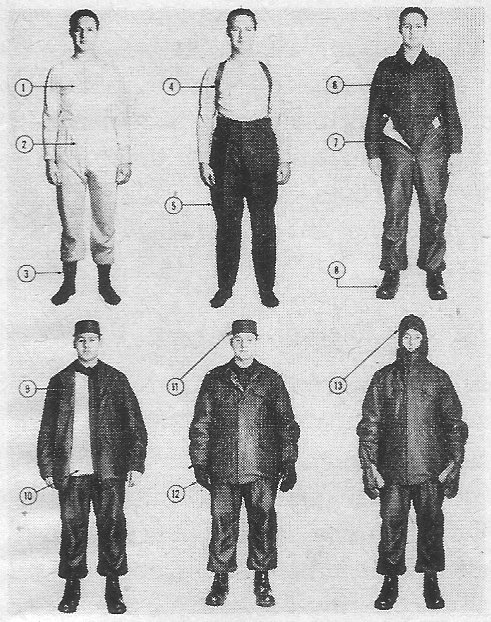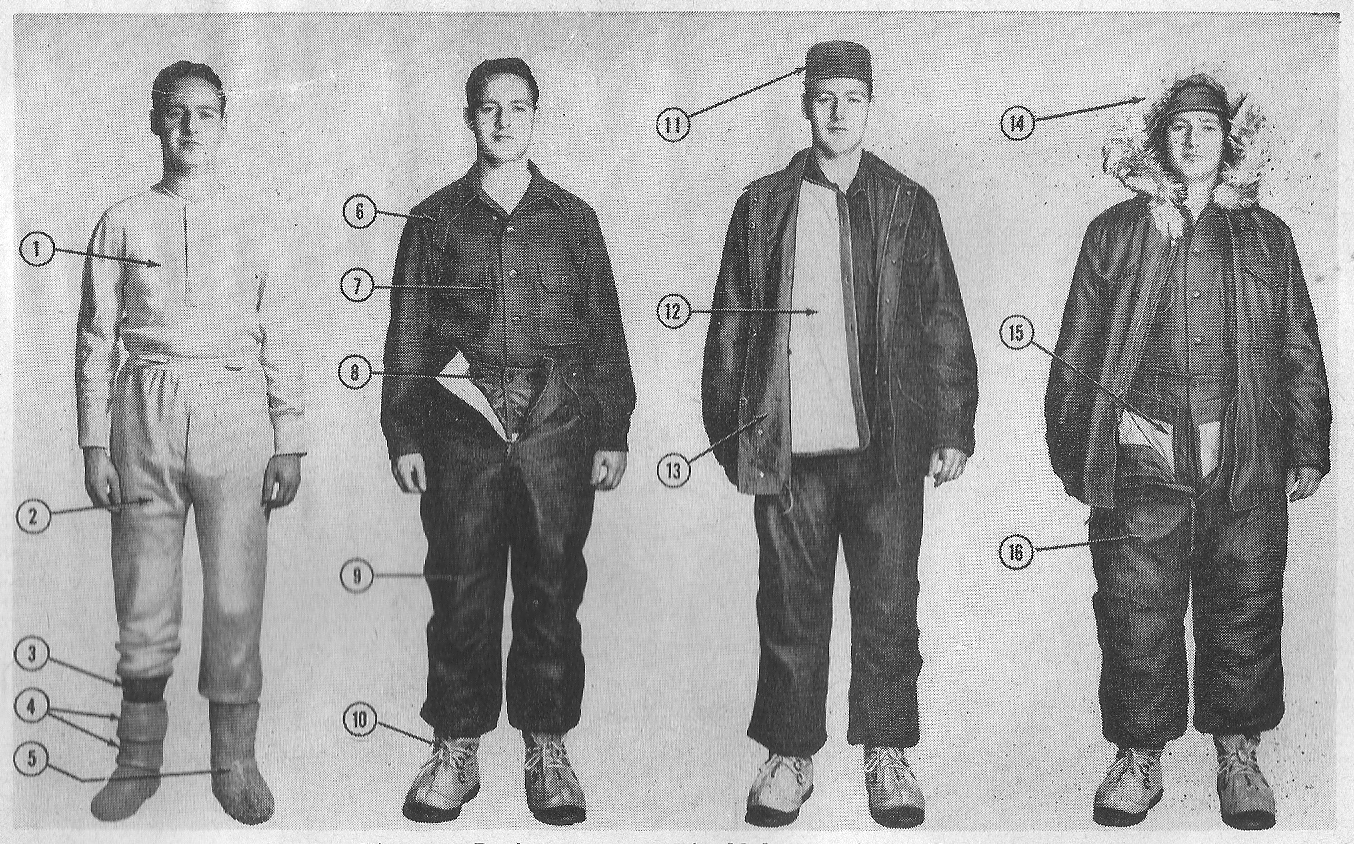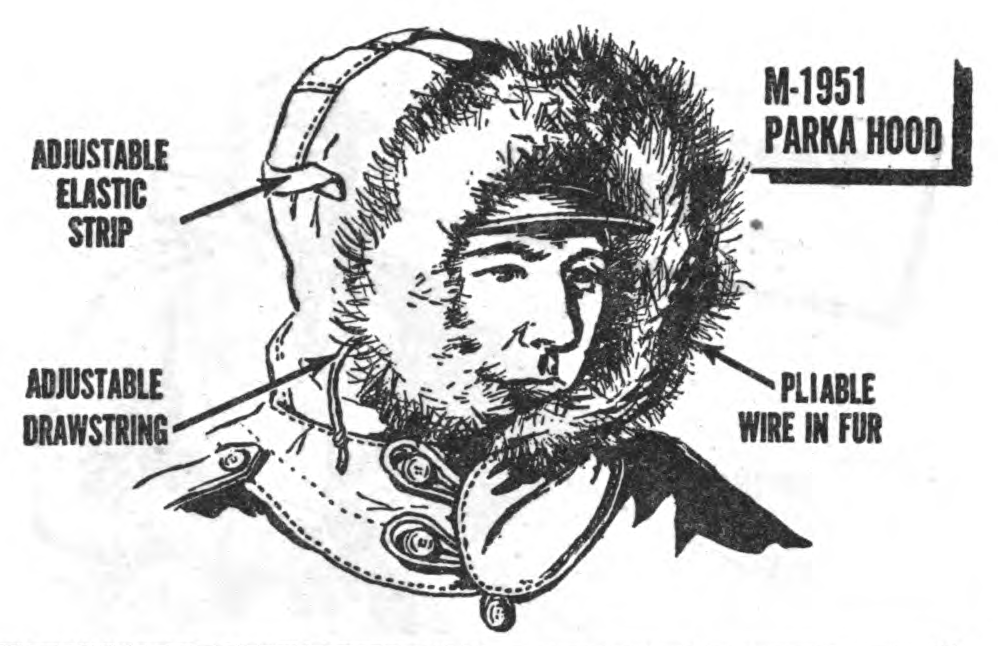Cold-Wet/Cold-Dry Clothing System
The combination Cold-Wet/Cold-Dry Clothing System (M-1951) can be configured into two ensembles. The cold-wet ensemble is worn above 14°F, and the cold-dry ensemble is worn below 14°F. The cold-dry ensemble protects down to -60°F. The cold-wet configuration differs from the cold-dry in the number of layers and the choice of boots. The system uses layers of wool/cotton fabrics to trap air for insulation, and a water-repellent outer garment to maintain dryness.
 figure 1. basic components of cold-wet weather uniform
figure 1. basic components of cold-wet weather uniform figure 2. basic components of cold-dry weather uniform
figure 2. basic components of cold-dry weather uniformCold Weather Conditions
The use of cold weather clothing is affected by two types of weather conditions: wet and dry. These conditions are amplified by humidity coupled with temperature and wind velocity; high humidity (wet conditions), low humidity (dry conditions).
Cold-wet conditions occur when temperatures are near freezing and variations in day and night temperatures cause alternate freezing and thawing. This freezing and thawing is often accompanied by rain and wet snow, causing the ground to become muddy and slushy. During these periods troops should wear clothing which consists of a water-repellent, wind-resistant outer layer and inner layers with sufficient insulation to provide ample protection in moderately cold weather (above 14°F).
Cold-dry conditions occur when average temperatures are lower than 14°F. The ground is usually frozen and snow is usually dry, in the form of fine crystals. Strong winds cause low temperatures to seem colder and increase the need for protection of the entire body (windchill). During these periods, troops should have available additional insulating layers of clothing. This is particularly true when entering static situations form a period of strenuous exercise.
Components
| Layer | Cold-Wet (fig. 1) | Cold-Dry (fig. 2) | |
|---|---|---|---|
| Inner | winter undershirt and drawers (1, 2), trouser suspenders (4) | winter undershirt and drawers (1, 2), trouser suspenders (6) | |
| The suspenders may be worn over the undershirt and support the drawers and all succeeding layers of trousers. | |||
| Intermediate | top | wool flannel shirt (6) | wool flannel shirt (7) |
| The shirt may be worn either tucked inside the trousers for additional warmth or outside the trousers for better ventilation. | |||
| bottom | wool serge trousers (5) | field trouser liner (8) | |
| Outer | top | field coat with liner (9, 10) | field coat with liner (13, 12), parka with liner |
| bottom | field trousers (7) | field trousers (9), arctic trousers with liner (16, 15) | |
| Snow Camouflage | parka, trousers, rucksack cover, mitten shell | ||
| Headwear | field cap (11), pile field cap, winter hood (13) | field cap (11), pile field cap, winter hood with fur ruff (14) | |
| Handwear | black leather gloves (12) with inserts, special cotton insert gloves (in summer months for protection against insect bites), trigger finger mitten shells with inserts | black leather gloves with inserts, special cotton insert gloves, trigger finger mitten shells with inserts, lightweight anti contact gloves (for delicate finger operations), arctic mitten set | |
| Footwear | OD-9 wool cushion sole socks (3), mickey mouse boots (8) | OD-9 wool cushion sole socks (3), 2 pair of natural wool socks (4), white wool felt socks (5), mukluk boots (10), bunny boots (not shown) | |
items 4, 5 and 10 of the cold-dry ensemble and pile field cap of the cold-wet and cold-dry ensembles were rescinded in Changes No. 1, 15 January 1963, to FM 31-70, 24 February 1959.
Replacements
- Some items were replaced by M65 items.
References
- FM 31-70. 1959. Chapter 2.
- http://hdl.handle.net/2027/uiug.30112101586482?urlappend=%3Bseq=151




